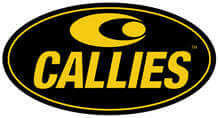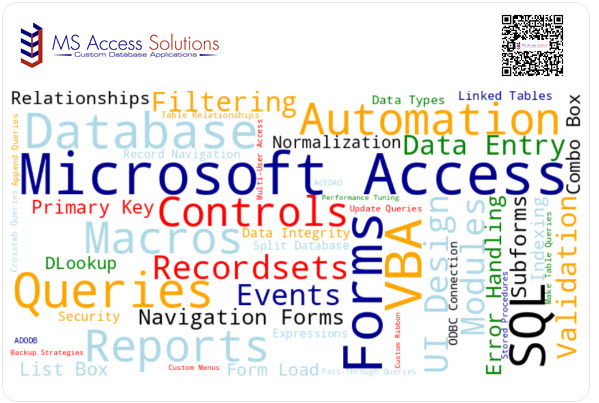
MS Access As A Dev Tool
Access continues to be a highly efficient tool for business database development.
The Best Microsoft Access Database Solutions owner, consultant, and principal programmer is Alison Balter - a recognized expert Microsoft Access consultant. Alison is the author of 15 Microsoft Access training books and videos. She is a frequent guest speaker at MS Access conferences and has developed hundreds of applications for businesses of all types.
We know your business data is important; we listen to your concerns, ask questions, and gather information from all stake holders. We discuss your needs and requirements for your database. We find out what you want, why you need various features so we can obtain as much information as possible. Once we have the information we need, we work with you to design the proper database architecture, plus the dashboards, the questions (queries), forms, and reports you need for an excellent database system.

We also create websites designed for speed to display your data accurately, using ASP.NET technology. Fast, secure, and robust, our ASP.NET web sites and web applications give you true business tool for finding and displaying information dynamically on the web.






Access continues to be a highly efficient tool for business database development.

How to create a Microsoft Access application with some unique tips and tricks.

Your Access developer near me has some great info for you about using Access efficiently.

Need help with your Access database? Call MS Access Solutions at (323) 285-0939 for your Complimentary Consultation.
The material below originally appeared in Alison Balter's book Mastering Microsoft Office Access 2007 Development and is reprinted here with the author's permission. There may be references to "Figures" or "Chapters"that are not reprintable and are not used on this page.
Image controls are your best option for displaying static images, such as logos, on a report. You can modify an unbound object after it is placed on a report, but you can't open the object application and modify an image when it's placed on a report. This limitation, however, means far fewer resources are needed, so performance improves noticeably.
As mentioned in a previous section, it's standard to include mostly labels and text boxes on your reports, but you can add other controls when appropriate. To add any other type of control, click to select the control; then click and drag to place it on the report.
Reports have many different properties that you can modify to change how the report looks and performs. Like Form properties, Report properties are divided into categories: Format, Data, Event, and Other. To view a report's properties, first select the report, rather than a section of the report, in one of two ways:
After you have selected a report, you can view and modify its properties.
When you select the report, the property sheet shows all the properties associated with the report. To select the report and open the property sheet at the same time, double-click the Report Selector. A report has numerous properties available on the property sheet (additional properties are available only from code) broken down into the appropriate categories in the property sheet. Forty of the properties relate to the report's format, data, and other special properties; the remaining properties relate to the events that occur when a report is run. The format, data, and other properties are covered here, and the event properties are covered in Chapter 11 in Mastering Microsoft Office Access 2007 Development.
A report has the following Format properties for changing the report's physical appearance:
This material originally appeared in Alison Balter's book Mastering Microsoft Office Access 2007 Development and is reprinted here with the author's permission.
When you need a Microsoft Access programmer for your Cincinnati, Ohio business, call MS Access Solutions at (323) 285-0939. We have over 25 years experience developing Microsoft Access programmer solutions. We create Access database applications for all industries, including but not limited to, hospitals, government agencies, the U.S. military, universities, human resources departments and career consults, agriculture, and insurance companies. We work with the most difficult and complex Microsoft Access challenges. We also provide SQL Server database programming for our clients and seamlessly connect Microsoft Access as a front-end data manipulation application to SQL Server. We work with smaller projects too. Projects include fixing damaged Access database forms, repairing MS Access reports and queries, re-coding Microsoft Access macros, and developing Visual Basic for Applications (VBA) code.
Creating effective Microsoft Access reports starts with a well-structured database. A report should pull data from optimized queries rather than directly from tables. Queries allow for filtering, sorting, and calculations before the data reaches the report, improving performance and accuracy.
Organizing the report layout is key. Grouping related data together makes information easier to read. For example, a sales report grouped by region or Adding totals and averages in group footers helps summarize key metrics without overloading the report with unnecessary calculations.
Using forms to filter reports makes them more user-friendly. Instead of hardcoded filters, allow users to select a date range, category, or other criteria before running the report. This keeps reports flexible and prevents unnecessary data processing.
Formatting plays a big role in readability. Use consistent fonts and spacing, and highlight important data with conditional formatting. Large images can slow down reports, so instead of embedding them, store file paths in the database and load them dynamically.
For complex reports, avoid excessive subreports, which can slow processing. Instead, use queries to combine data before sending it to the report. If working with large datasets, linking Microsoft Access to SQL Server and using pass-through queries can speed things up significantly.
Automating reports saves time. Scheduling reports to run at specific times and automatically exporting them to PDF or Excel makes data sharing more efficient. A well-optimized report runs smoothly, presents information clearly, and delivers insights without delays.
Get more information about our Microsoft Access programmer services at the Microsoft Access Programmer Cleveland, Ohio web page.

